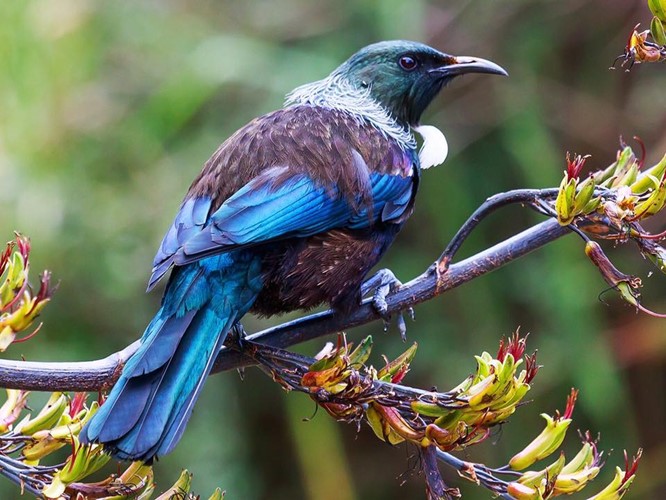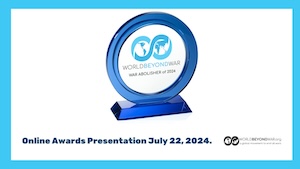
Tui bird, native of Aotearoa New Zealand, also known as the Parson Bird.
By John Reuwer, World BEYOND War, June 14, 2024
John Reuwer, a retired emergency physician and long-time educator and activist for peace, along with his wife, Laurie Gagne, a retired Theology and Peace and Justice Professor, travelled throughout New Zealand during the month of February. In 10 towns and cities John gave 13 presentations on World BEYOND War and its alternative vision for national security. The speaking tour was organized by Hawkes Bay Quaker Liz Remmerswaal, Vice President of World BEYOND War.
Laurie Everywhere we went—from Paihia to Dunedin—we were hosted by Friends who all seemed to know each other! It’s these relationships, I suspect, which have made Quakers a force in the larger New Zealand peace movement in the past and can be the foundation for their contributions to current demilitarizing efforts such as the Stop AUKUS Campaign.
John: For me this was a golden opportunity to take George Fox’s advice to walk cheerfully over the world, answering that of God in everyone. It was easy to see that of God in the many Friends who have such a proud history of living out the Quaker peace testimony by participating in the various Aotearoa/New Zealand contributions to world peace. We discussed the many challenges to peace in a world that seems addicted to violence, and inspired each other with stories of Māori nonviolence, the highly successful anti-nuclear movement, A/NZ’s contribution to peacekeeping, and how all these fit in the vision of World BEYOND War.
Laurie: We thought of ourselves as “peace pilgrims” because we were learning so much from the people we met. There was a memorable conversation with Nanaia Mahuta (introduced to us by Gray Southon) who told us that peace and reconciliation are the “super powers” of the Māori and how she, as Minister of Foreign Affairs and Trade, had relied on Māori values such as manaaki (kindness) and whanaunga (connection or shared humanity) in diplomacy and negotiations.
We were in Waitangi on February 5th and 6th and learned about the Treaty and the partnership between Māori and Pākehā. There is nothing equivalent in the U.S. and it is fair to say that Native Americans have far less status in our society than Māori have in New Zealand. The Waitangi Tribunal, established in response to a mass movement of Māori and their allies in 1975, we found particularly impressive. It is remarkable that it has recommended and won hundreds of millions of dollars in reparations for different Māori tribes to date.
John: I had been aware of ANZ’s successful peacekeeping mission to Bougainville through the movie Soldiers Without Guns. I heard more in Auckland from its producer Will Watson, and again in Wellington from Fiona Cassidy who played a major role as a Māori Defence Force officer supporting the women in Bougainville who were trying to make the peace. Phillip Taula of the Ministry of Foreign Affairs and Trade, and another Friend in Nelson, both of whom had spent years in the region of Papua New Guinea, confirmed that despite continued political challenges, the peace has held in the 26 years since, and the memory of that unarmed mission is strong.
Laurie: The highlight of our trip to New Plymouth–where John gave a well-received talk organized by Rob Green and Margy-Jean Malcolm–was our visit to Parihaka, arranged by our host, Rob Ritchie. We were there for the monthly meeting, which lasted most of the day with a break at noon for a very substantial lunch. As we processed into the marae to begin the meeting, I had a sense of the presence of the ancestors, whose photographs covered the walls. It reminded me of the Catholic idea of the cloud of witnesses, those who have gone before us to whom we are accountable. When it came time for the guests to give speeches, the group gave approving nods to John’s “War Sucks” shirt and seemed to appreciate an insight I shared from our conversation with Nanaia Mahuta. It had to do with communicating spiritual values to children. She reminded me that instead of teaching them to believe this or that, we should encourage them to heed their own inner voice.
John: The amazing story of Parihaka, when the former warriors Tohu Kakahi and Te Whiti o Rongomai literally turned their swords into ploughshares and challenged the colonial takeover of their land, came alive for me seeing the gravesite of Te Whiti, their marae, and their descendants still on the land they refused to yield. They were prisoners and displaced, but Te Whiti’s prediction that “the future is mine, and little children, when asked hereafter as to the author of peace, shall say ‘Te Whiti’ – and I will bless them.” was true. May we remember this story when we who practice nonviolence are challenged by those who insist that violence is necessary to preserve that which we value.
Laurie: Another highlight was our visit to the Quaker Settlement in Whanganui. Our host was Marian Sanson, who organized a lovely potluck before John’s talk which attracted 50 people. At the morning Meeting for Worship, we met Merilyn Payne, who is the woman I want to be at 85. She led us on a tour of the grounds, explaining that she and her husband had led the community in planting all the trees! At one point, we helped her root out an invasive species from the side of a hill. I can still picture her scrambling up and down the hill not once missing a beat in our lively conversation. What was obvious to us is that she loves the land intensely. After John’s talk, she recommended that World BEYOND War add “connecting with the earth” as part of its program of Peace Education. Healing relationships is what peace is all about, she said, and our relationship to the earth is fundamental.
Laurie: From Nelson Friend, John Michaelis, we learned about the Alternatives to Violence Project which has helped heal prisoners and reduced bullying in schools all over the world. John and his wife Anthea took us on our longest tramp of the trip -four hours on the Abel Tasman Trail, which was followed by a wild ride on a boat taxi and a visit to a sacred pool.
Laurie: In Christchurch, after visiting the Peace Bell, we had lunch with anti-nuclear activists, Kate Dewes and her husband, Robert Green. Rob is the author of Security Without Nuclear Deterrence and Kate has held many important roles in the anti-nuclear movement, most recently, as Co-Director, with Rob, of the Centre for Disarmament and Security. Kate wears her expertise lightly. She was full of funny stories, but we got her to reflect on key moments in the civil society movement that made New Zealand a nuclear-free zone in 1987. It was the nuclear testing in the South Pacific that started it, she said, but it was the attack on the Greenpeace boat, Rainbow Warrior (by the French) that solidified public opinion. According to Kate, New Zealand remains staunchly anti-nuclear today.
That evening, John spoke to a crowd of 90 people–our largest audience of the tour. (Hats off to our hosts, Deborah Williams and her husband David Minifie, for their superb organizing skills!) Many people, including Fr Jim Consedine, author and activist, and Kathleen Gallagher, celebrated poet, playwright, and filmmaker, commented that it was good to have an event that brought so many “peace people” together. We loved seeing young people in the audience; some of them, we found out, are pursuing advanced degrees in Peace Studies.
John: The last of our formal presentations took place In Dunedin under the leadership of Richard Jackson, Director of the National Centre for Peace and Conflict Studies at Otago University. As with most of our meetings, discussion went on for a long time. Professor Jackson and his graduate students recently published Abolishing the Military: Arguments and Alternatives. This small book outlines the threats to A/NZ’s future and questions whether its military is the best answer to those threats. I suggest this book be circulated far and wide, and serve as a guide for discussions about A/NZ’s domestic and foreign policy and budget for the foreseeable future. World BEYOND War would like everyone in every country to ask this question about their military.
We close with a big thank you to the many friends we made on the trip. In addition to those mentioned above, Jane Banfield in Paihia, Val Bone and Ann Banks in Auckland, Jan and John Schmidt in Wellington, Carrie Barber in Hamilton, Liz and Ton Remmerswaal in Hawkes Bay, Gwen Struik in Nelson, and Catherine Spencer and Marvin Hubbard in Dunedin were all fantastic hosts. Above all, we want to thank the tour organizers, especially the amazing Liz Remmerswaal and the abundantly generous Gray Southon (he gave us his car for three weeks!) without whom this trip would not have taken place. Our visit to Aotearoa/New Zealand changed our lives. We hope it left you with a little hope and a lot to think about. Kia ora!








